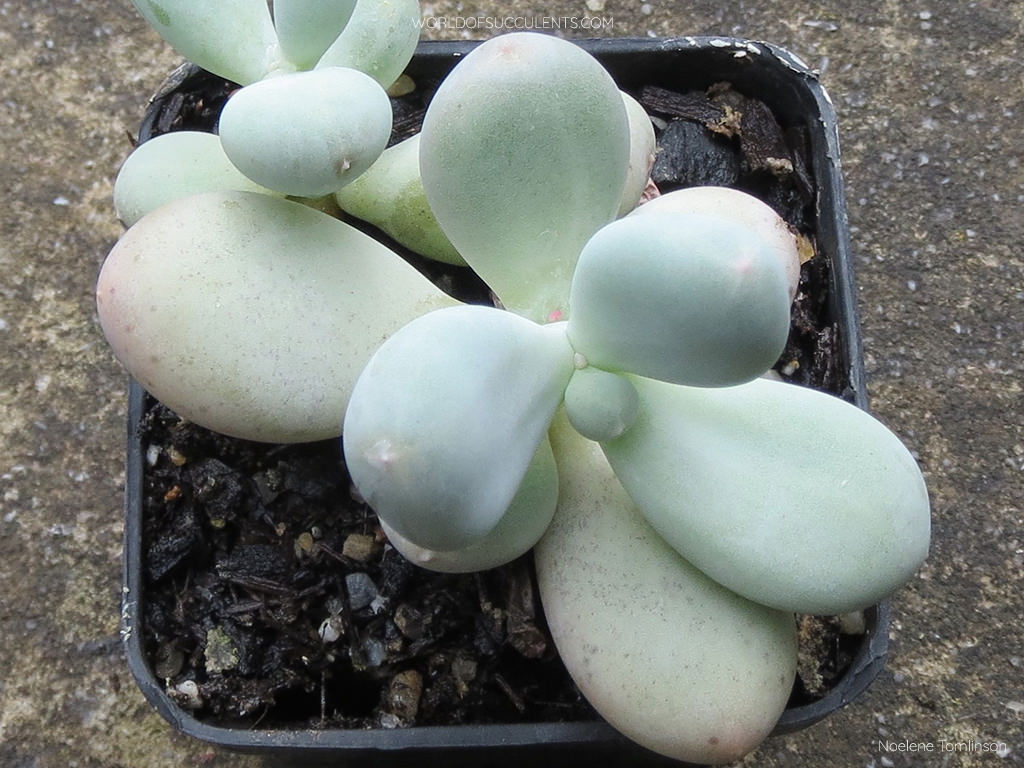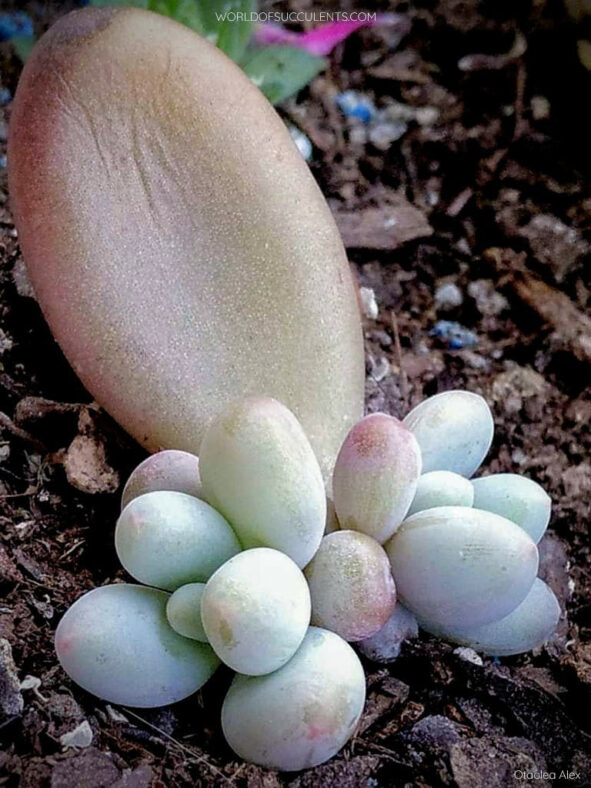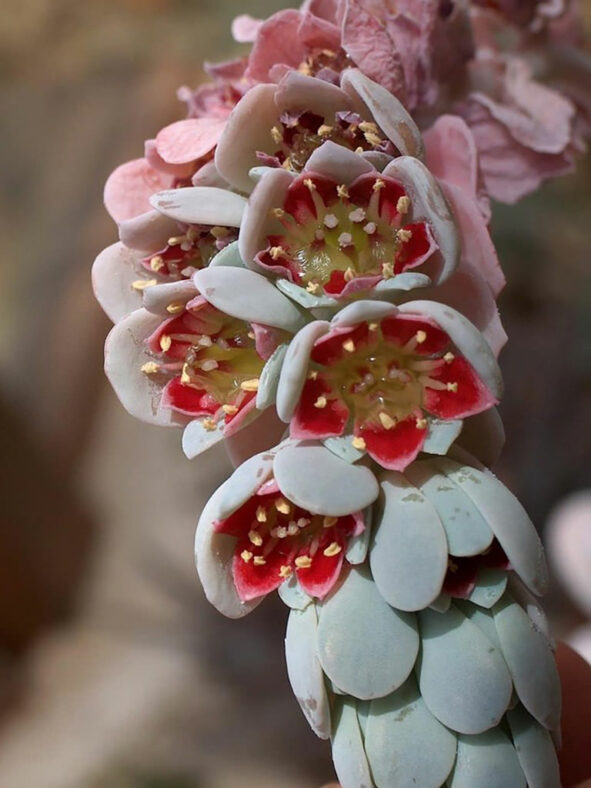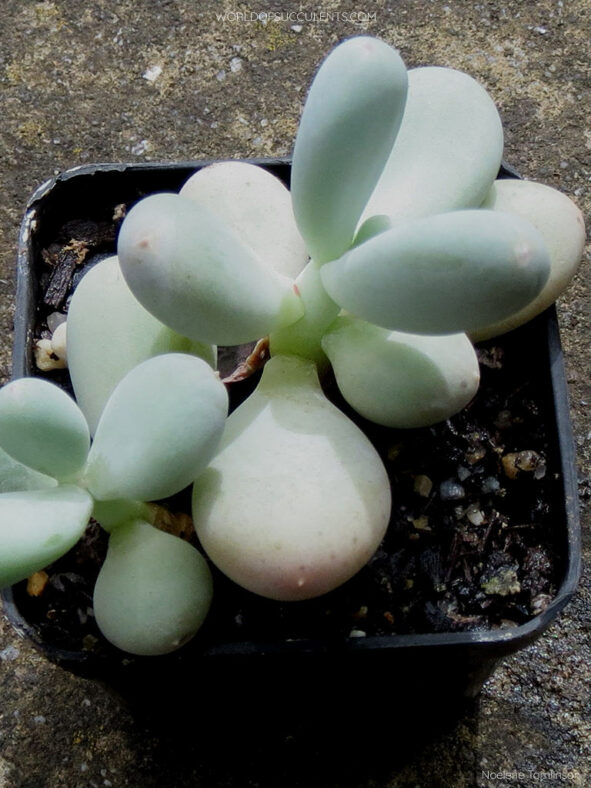Pachyphytum bracteosum is a perfect plant for growing in a container, on its own, or as part of an arrangement.
Scientific Name
Pachyphytum bracteosum Klotzsch
Common Name(s)
Moonstones, Silver Bracts
Synonym(s)
Cotyledon pachyphytum, Echeveria bracteosa, Echeveria pachyphytum
Scientific Classification
Family: Crassulaceae
Subfamily: Sedoideae
Tribe: Sedeae
Subtribe: Sedinae
Genus: Pachyphytum
Etymology
The specific epithet "bracteosum (brak-tee-OH-sum)" means "having bracts" and refers to the inflorescences with large bracts in the upper part.
Origin
Pachyphytum bracteosum is native to Mexico. It grows on rocks at elevations ranging from 3,940 and 5.910 feet (1.200 to 1.800 m) in the region of the Barranca de Metztitlán in Hidalgo.
Description
Pachyphytum bracteosum is a small succulent that forms rosettes of plump, grey-gray-green, somewhat distant leaves with a thick, powdery coating. As it grows, it can become a loose, upright subshrub. The stems are erect or decumbent, simple or few-branched near the base, and can reach up to 12 inches (30 cm) long and 1 inch (2.5 cm) in diameter. The leaves are obovate to spoon-shaped, measuring up to 4.4 inches (11 cm) long, 2 inches (5 cm) wide, and 0.6 inches (1.5 cm) thick. When exposed to bright sunlight, the leaves take on pink or purple hues.
During the late spring and early summer, the plant produces reddish, arching stalks with bell-shaped flowers. The flower stalks can grow up to 16 inches (40 cm) long. The flowers have rose-colored petals partially hidden by unequal sepals and large bracts the same color as the leaves.
The closest relatives to this species are Pachyphytum oviferum and Pachyphytum longifolium.

How to Grow and Care for Pachyphytum bracteosum
Light: Pachyphytum bracteosum thrives when exposed to direct sunlight. While it can tolerate partial shade, it may result in slightly rangy growth. When growing indoors, keep it near a sunny window.
Soil: This plant requires good drainage to maintain a healthy root system. While many growers prefer to create their own soil mix, commercial soil for succulents will work fine.
Temperature: Pachyphytum bracteosum is a winter grower and will stop actively growing when it warms up. It grows best in USDA Plant Hardiness Zones 9b to 11b, with average minimum winter temperatures ranging from 25 to 50 °F (-3.9 to 10 °C).
Watering: Although a winter grower, this plant is most active during spring and fall. Water thoroughly, then wait for the soil to dry out completely before watering again. During the winter, water sparingly. As the plant goes dormant in spring, it does not need to be watered except for arid conditions.
Fertilizing: To promote healthy growth and flower production, apply a water-soluble fertilizer diluted to half the recommended strength during the growing season.
Repotting: If growing Pachyphytum bracteosum in a container, repot it in a pot with drainage holes when it outgrows its pot. Give the plant a week or so to readjust before you water it.
Propagation: The easiest method to propagate this plant is by stem cuttings, although it can also be propagated from leaves and seeds. Even a leaf that drops off will root below the parent plant and produce a new plant. For best results, take cuttings in the spring and sow the seeds in the spring and summer.
Learn more at How to Grow and Care for Pachyphytum.
Toxicity of Pachyphytum bracteosum
Pachyphytum bracteosum is generally non-toxic to humans and pets.
Hybrids of Pachyphytum bracteosum
- Pachyphytum 'Blue Haze'
- Pachyphytum 'Captain Jessop'
- ×Pachyveria 'Clavata'
- ×Pachyveria 'Clavifolia'
- ×Pachyveria 'Myrtilla'
- ×Pachyveria 'Scheideckeri'
Links
- Back to genus Pachyphytum
- Succupedia: Browse succulents by Scientific Name, Common Name, Genus, Family, USDA Hardiness Zone, Origin, or cacti by Genus
Photo Gallery


